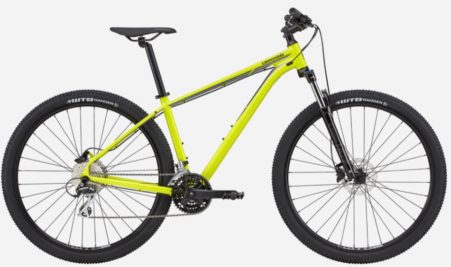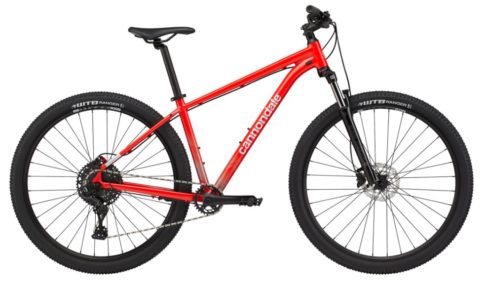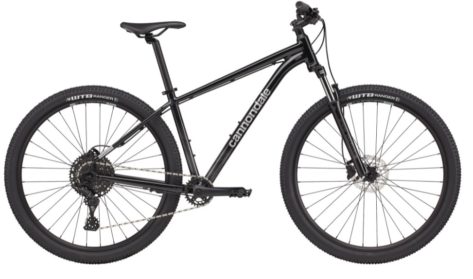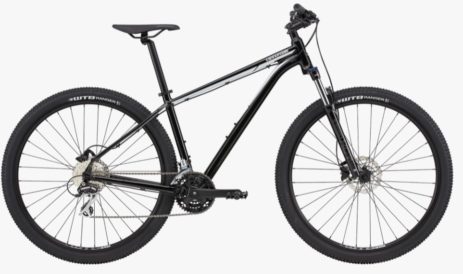While Cannondale is popularly known for high-end mountain bikes, not every MTB costs an arm and a leg. Two of its MTBs priced under $1,000 are the Cannondale Trail 5 and Cannondale Trail 6. So, what’s the difference between Cannondale Trail 5 vs Trail 6?
While Trail 5 comes with a 10-speed Microshift Adrant X drivetrain, SR Suntour XCM fork, and Tektro disc brakes, Trail 6 features a 2×8 speed Shimano Acera/Altus drivetrain, SR Suntour XCT fork, and Shimano disc brakes.
Since Trail6 offers a 2×8 speed drivetrain, it has 16 gears, while Trail 5 only has 10 (1×10). So, Cannondale Trail 5 and Trail 6 differ primarily in the drivetrain, suspension fork, and brake type.
You’ll also notice that the component difference results in a price difference where Trail 5 costs $100 more than Trail 6. Additionally, you can differentiate the two trail bikes according to their frame colors.
Below is a table summary showing the comparison between these two Cannondale Trail bikes (2021 versions).
| Feature | Cannondale Trail 5 Review | Cannondale Trail 6 Review |
| Drivetrain | 1×10 speed Microshift Advent x10 | 2×8 speed Shimano Acera/Altus 16 |
| No. of Gears | 10 | 16 |
| Brakes | Shimano hydraulic disc brakes | Tektro hydraulic disc brakes |
| Suspension Fork | SR Suntour XCM fork 100mm | SR Suntour XCT fork 100mm |
| Cost | $950 | $850 |
| Frame Colors | Rally red and graphite | Nuclear yellow and silver |
I’ll explore all the six differences in detail later. In addition, I’ll talk about the things that these bikes have in common. That includes their frames, wheels, and sizing.
So, let’s get started.

Cannondale Trail 5 Vs Trail 6 Differences
Let’s compare these two Cannondale Trail bikes under the following:
1. Drivetrain
Trail 5 comes with a 1×10 speed Microshift Advent X drivetrain characterized by the following:
- 10-speed Microshift Advent X shifters
- Microshift advent X rear derailleur
- Microshift 11 – 48T 10-speed rear cogs
- Charm 30T pro wheel crank
- KMC X 10 chain
Overall, the 1×10 drivetrain delivers the smoothest shifting experience. It allows you to take on gravel surfaces and low-impact trails more confidently, making Trail 5 a fantastic entry trail bike.
On the other hand, Trail 6 comes with a 2×8 speed Shimano Acera/Altus drivetrain characterized by the following:
- 2×8 Shimano Altus shifter
- Shimano Acera rear derailleur
- Sunrace 11-34T 8-speed rear cogs
- 42/32/22 pro wheel forged alloy crank
- KMC X8 chain
Overall, its 2×8 Shimano Altus delivers a smooth and efficient shifting experience. It’s the reason this bike can take on gravel surfaces and low-impact trails like its counterparts above.
Most riders who have tried Microshift advent x and Shimano Acera/Altus will tell you that the former is slightly more reliable and offers a smoother riding experience.
So, even though Trail 5 only has a 1×10 speed drivetrain, it offers you enough at an entry-level.
2. Cannondale Trail 5 Vs Cannondale Trail 6 Gear Number
Trail 5 comes with a 1×10 drivetrain that translates to 10 gears (or ten speeds). In contrast, Trail 6’s 2×8 drivetrain promises 16-gears, six more than what you get from Trail 5.
Then comes the question, does the gear number matter? Ten speeds are enough to get you to the top when tackling hills.
But once it comes to tackling mountains, you need more confidence, and a bike with more gears offers you that, which favors Trail 6.
But since both bikes are entry-level choices, you may not have a chance to tackle the steepest mountain, and you’ll most likely tackle hills and gravel roads. So, the gear number won’t make much difference.

3. Brake Type
While both bikes have hydraulic disc brakes which promise unmatched stopping force and excellent control, the brand type differs. While Tektro brakes are not as popular as their Shimano counterparts, they are equally powerful, reliable, and have a good feel.
They also employ the same stopping mechanism as Shimano brakes, and both are entry-level choices. So, it’s unfair to say that one is better than the other.
Both are also easier to clean, fix, and set up. So, as far as the brakes are concerned, both disc brakes are of decent quality.
4. Suspension Fork
One thing is for sure; both MTBs offer you an SR Suntour fork with 100mm travel. Forget about the ‘SR Suntour’ part briefly and focus on the 100mm travel!
100mm is enough for an entry MTB to soak up bumps and potholes and guarantee a smooth and more controlled ride. That’s what you get from both.
Now onto the SR Suntour part; SR Suntour XCT is lighter than the SR Suntour XCT fork. As a result, Trail 6 may feel slightly wobbly when the wheel is off the ground.
However, you may not have such an experience with Trail 5 as it has a less wobbly front. That explains why you pay $100 more for Trail 5.
5. Cannondale Trail 5 Vs Trail 6 Price
There is a $100 price difference between Trail 5 (which goes for $950) and Trail 6 (retailing at $850). But why is that the case?
One reason is what I mentioned earlier – the suspension fork. Trail 5 doesn’t wobble off the ground as Trail 6, making it more comfortable, thus slightly costly.
The other difference is the drivetrain difference. Microshift Advent X slightly edges Shimano Acera/Altus in performance, making Trail 5 costlier than Trail 6.
6. Color Choices
Cannondale Trail 5 comes in rally red and graphite color choices. Rally red is a blend between red and pink, while graphite is a blend between black and blue. So, rally red is for the bold rider while graphite is for the low-key bikers.
Trail 6, in contrast, comes in nuclear yellow and silver color choices. The nuclear yellow is feminine, while silver is unisex. But overall, anyone can go for any frame color, depending on preference.

Similarities between Cannondale Trail 5 and Trail 6
After looking at the things that set these two Cannondale Trail bikes apart, it’s worth mentioning the things they share. They include the following;
Bike Size
Trail 5 and Trail 6 come in five frame sizes to accommodate riders between 4’6¨ – 6’3¨ as follows:
| Frame Size | Riders Height |
| X-small | 4´6¨ – 5´2¨ |
| Small | 5´1¨ – 5´4¨ |
| Medium | 5´4¨ – 5´8¨ |
| Large | 5´7¨ – 6´0¨ |
| X-large | 6´0¨ – 6´3¨ |
Bike Type
Both Cannondale Trail 5 and Trail 6 are trail bikes with a front suspension (hardtail). Their 100mm SR suspension fork promises significant bump absorption, and you need that to go through gravel roads and local trails.
Frame Type
Both bikes come with Smart Foam C3 alloy frames (another name for aluminum). The advantage of the frame material is that it is lightweight, strong, comfortable, and durable.
It may not be as high-end as carbon but offers you something close to it on a budget.
Geometry
Both bikes have a 68-degree head angle that gives them a stiffer look which promises exceptional handling downslopes. You get to charge down the hill with confidence because of their stiffer geometry.
Cable Routing
These two MTBs have an internal cable routing design that protects the cables from weather damage and easy wear.
More importantly, the design gives the frames a sleeker look, which improves their overall riding speed.
Wheel Size and Type
Both MTBs come in 29-inch (29er) and 27.5-inch options. Plus, they feature 2.25-inch wide WTB Ranger comp tires and 32-hole WTB rims with stainless steel spokes.
So, you get the same wheel size and tire quality. The wheels generally make these MTBs trail-ready, and they are pretty strong to take all low-impact trails and gravel surfaces.

Other Components
Trail 5 and 6 also share these components:
- Riser handlebars with an 8-degree sweep and a 6-degree rise keep you cycling in a comfortable upright position.
- 6061 alloy stem for a lightweight feel
- 6061 alloy seat post, which is compatible with a dropper post.
- Cannondale Stage 3 saddle, which is pretty comfortable and lightweight
- Disc brakes that promise crisp and responsive stoppage
Which One Between Cannondale Trail 5 and Trail 6 Suits You More?
There’s no denying that Cannondale Trail 5 and Trail 6 have so much in common. Their frames, wheels, brakes, handlebars, and geometry, for example, are similar, making the decision hard.
Both bikes are hardtails and have the same design too. So, how do you choose between them?
Choose Cannondale Trail 5 if you are ready to spend $100 more on a hardtail that offers you more control and a more efficient drivetrain.
Alternatively, go for Cannondale Trail 6 if you are budget tight but want a quality hardtail that offers more gears, decent suspension, and quality brakes.
But overall, Trail 5 and Trail 6 prove that Cannondale bikes are good.
People Also Ask
1. What Is the Difference Between a Cannondale Trail 5 And 6?
The biggest difference between Cannondale Trail 5 and trail 6 is that the former offers you a better drivetrain while the latter offers you more gears.
But other than that, these bikes don’t have a lot to split them. They’ve so much in common as they are both hardtails by the same company.
2. How Much Is a Cannondale Trail?
Cannondale Trail 5 retails at $950, while Trail 6 goes for $850, all 2021 versions. Note, however, that the prices keep changing yearly depending on the trail bike model.
3. Are Cannondale Mountain Bikes Good?
Cannondale mountain bikes are good-quality bikes characterized by durable frames and high-end components.
They are equally comfortable riding and better performers at a competition level, thus good value for money. So, without a doubt, Cannondale mountain bikes are good.
4. How Many Speeds Is the Cannondale Trail 6?
2021 Cannondale Trail 6 comes with a 2×8-speed drivetrain which translates to 16 speeds. The gear number is enough to allow you to efficiently shift across an array of low-impact trails and gravel surfaces.
5. How Much Does a Cannondale Mountain Bike Cost?
A budget Conondale bike such as the Cannondale Trail 5 or Trail 6 goes for under $1,000 while mid-range options average $1,500 – $2,750. You may, however, get high-end options for about $3,675 and above.
Closing Remarks on Cannondale Trail 5 Vs Trail 6!
Generally, while Cannondale Trail 5 and Trail 6 have so much in common, they both promise different things, which sets them apart. Trail 5 promises a slightly higher-end drivetrain at a basic level, while Trail 6 promises more speed.